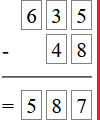Subtraction operations
Example
5 |
6 |
3 |
5 |
4 |
|
| - | 2 |
8 |
9 |
1 |
7 |
| = | 2 |
7 |
4 |
3 |
7 |
How to do ?
In this exercise, we propose the Subtraction operation.
The first thing the student needs to know is how to align the terms of the operation correctly. For the terms of the addition to be correctly aligned, it must be :
- The units digit of the 2th term is placed under the units digit of the 1st term,
- the tens digit of the 2th term is placed under the tens digit of the 1st term,
- the hundreds digit of the 2th term is placed under the hundreds digit of the 1st term,
- and so on ...
In other words, the two terms of the addition must be aligned to the right.
For example, the operation
249 + 64
Correct positioning :

Incorrect positioning :

Next, calculate the difference column by column, starting from the rightmost column. In other words, calculate the difference between the digits of the units of the two terms and place the result in the digit of the units of the difference :
5 - 8 = ?
Since you can't subtract 8 from 5, I'll subtract 8 from 15 and retain the number 1 to subtract from the next column.
15 - 8 = 7

Now I have to subtract 4 and 1 from 3 :
3 - 4 - 1 = ?
This is not possible, so I subtract 4 and 1 from 13 and retain the number 1 to subtract it from the next column.
13 - 4 - 1 = 8

If a digit is missing, it is considered to be 0. And I have to subtract carry 1 from the previous column :
6 - 0 - 1 = 5
